Samburu National Reserve Travel Guide: A Journey to Kenya's Arid North
Located in the arid but beautiful terrains of northern Kenya, Samburu National Reserve has the potential to become the secret destination in the heart of adventurous travelers. Much less trodden than its southern rivals, Samburu presents the most raw and authentic type of safari, with dramatic scenery, exotic wildlife, and also rich cultural experience, with the Samburu people.
The reserve is surrounded on both sides by the life sustaining Ewaso Ngiro River and the challenging waters are home to some of Africa’s most distinctive wildlife has to offer featuring the Samburu Special Five; reticulated giraffe, Grevy’s zebra, Somali ostrich, gerenuk, and Beisa oryx. Whether it is golden savannah with some doum palms here and there or a magnificent view of the mount Ololokwe in the horizon, Samburu stimulates the senses as well as presents a wonderful photographic setting. Unlike higher-altitude parks such as the Maasai Mara, Samburu sits at a lower elevation, which makes it hotter and more arid throughout the year. This unique climate contributes to its distinct ecosystem and striking contrast between dry plains and lush riverine areas
This comprehensive travel guide will help you plan your journey to Samburu National Reserve, detailing the best times to visit, top wildlife sightings, accommodation options, and essential tips for an unforgettable adventure.
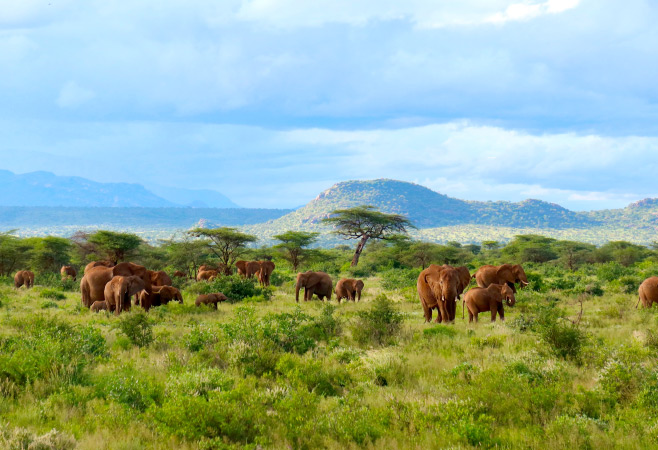
Samburu National Reserve is a famous destination for a Kenya safari, offering stunning landscapes and unique species
The Heart of Kenya's North: An Introduction to Samburu National Reserve
Where is Samburu National Reserve located ?
Samburu National Reserve is found in Northern Kenya or rather Samburu County.
It is north of the equator; a distance of 350 Km (220 miles) north of the capital city of Kenya, Nairobi. The reserve is located alongside the Ewaso Ng’iro River, which serves as an essential water source running through the semi arid environment within which its indigenous animals thrive.
Samburu forms part of Kenya’s celebrated Northern Safari Circuit and is geographically flanked by two other protected areas—Buffalo Springs National Reserve and Shaba National Reserve. These three are distinct but adjacent wildlife reserves, each managed separately, yet they collectively form a larger, interconnected ecosystem. Due to their proximity, they are often bundled together in safari itineraries covering northern Kenya.
Best Time to visit Samburu National Reserve
Samburu National Reserve is a superb year-round safari destination, but the best time to visit largely depends on your priorities—whether you want the best wildlife viewing, lush landscapes for photography, or fewer tourists for a more secluded experience.
Dry Season (Best for Wildlife Viewing)
- Months: June to October and December to March
- These are the prime months for a Samburu safari. During the dry season:
- Vegetation is sparse during this time, making animals easier to spot
- The reserve finds most of its wildlife in the Ewaso Ng’iro River which is the major source of water.
- There is more sunny and warm weather with reduced humidity.
- The roads are also improved thus traveling in the park is easier.
- The time also provides the most probable opportunities to spot the Samburu Special Five reticulated giraffe, Grevy’s zebra, Somali ostrich, gerenuk, and Beisa oryx
Green Season (Beautiful Scenery and Fewer Tourists)
- Months: Late March to May (long rains) and late October to November (short rains)
- During these months:
- The scenery changes to a green-filled paradise and is ideal to take photographs.
- Birdwatching is also superb, with migratory species being attained.
- The number of visitors is reduced and gives a calm kind of safari.
- However, from March to May, heavy rains are sometimes possible, and daytime temperatures may become extremely hot, potentially impacting accessibility and comfort.
- Despite the rains, Samburu typically experiences less rainfall than parks in southern Kenya, implying that game viewing can still be quite favorable even during the wet seasons.
- Some roads can become muddy or impassable, and animals may scatter more due to abundant water sources.
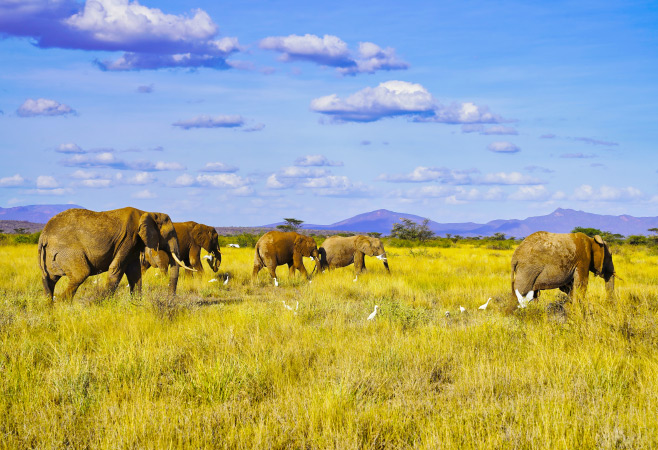
The best times for wildlife viewing are during the dry seasons
Samburu National Reserve park fees
Samburu National Reserve Entry Fees (Per 24 Hours)
|
Category |
Non-Resident |
East African Resident |
Kenyan Citizen |
|
Adult |
USD $85 |
KES 1,600 |
KES 800 |
|
Child (3–11 yrs) |
USD $50 |
KES 800 |
KES 500 |
|
Student |
USD $50 |
KES 800 |
KES 500 |
Children under 3 years: Free entry.
Student rates apply to individuals up to 23 years old on pre-arranged educational trips with valid student ID and prior approval.
Always check the latest entry fees on the official KWS website or with your safari operator before travel.
Camping Fees (Per Person, Per Night)
|
Category |
Non-Resident |
East African Resident |
Kenyan Citizen |
|
Adult |
USD $25 |
KES 800 |
KES 500 |
|
Child (3–11 yrs) |
USD $15 |
KES 500 |
KES 300 |
|
Student |
USD $15 |
KES 500 |
KES 300 |
A weekly camping reservation fee of KES 10,000 may apply for securing specific campsites.
Vehicle Entry Fees
|
Vehicle Type |
Entry Fee (KES) |
|
Safari Vehicle (<6 seats) |
800 |
|
Safari Vehicle (6–12 seats) |
1,600 |
|
Lorries & Buses |
3,000 |
|
Delivery Vehicle (2–5 tons) |
8,000 |
|
Annual Permit (stationed in park) |
45,000 |
Payment Methods
Payments can be made via Cash (USD or KES), Visa, Mastercard or Mpesa mobile payment
Ensure to carry valid identification to qualify for resident or citizen rates.
Opening Hours
The Samburu national reserve opens every day between 6:00 AM to 6:00 PM/weekends inclusive/ and on any holiday. During these hours only, the entry or exit will be allowed only in extreme cases by prior permission of the park warden.
Entry Gates to Samburu National Reserve
Samburu National Reserve in northern Kenya offers five main entry points, each providing unique access to different areas of the reserve and neighboring conservancies.
Archer’s Post Gate
- Located near Archer’s Post Gate, immediately adjacent to the Marsabit Highway.
- Ideal for: Road travelers arriving from Nairobi or Isiolo.
- Lodging options in the vicinity: Samburu Intrepids Luxury Tented Camp, Elephant Watch Camp, Samburu Sopa Lodge, Samburu Sentrim Lodge, Lion King Safari Bush Camp.
West Gate
- Location: Situated on the reserve's western edge, bordering the West Gate Community Conservancy.
- Access: Primarily intended for visitors of Sasaab Lodge; lodge rates encompass entry fees.
Kalama Gate
- Location: Approximately 7 km from the northern border of the reserve, within Kalama Conservancy.
- Best for: Guests staying at Saruni Samburu Lodge.
Uaso Bridge Gate
- Location: The eastern portion of the reserve, situated close to the Ewaso Ng’iro River bridge, which provides access to Buffalo Springs National Reserve.
- Best for: Tourists who are also planning to visit both Samburu and Buffalo Spring Reserve
- Nearby Lodges: Ashnil Samburu Lodge and Samburu Simba Lodge.
Central Airstrip Gate
- Location: Within the reserve, serving the central airstrip.
- Best for: Fly-in visitors; daily flights operated by Air Kenya and SafariLink.
Choosing the right entry gate, based on your accommodations and itinerary , can improve your safari experience. This selection minimizes travel time and offers simple access to your preferred location within the reserve.
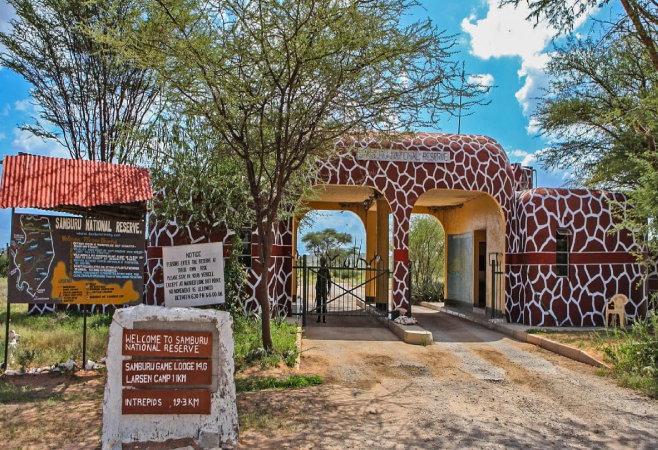
Entry and exit gates of Samburu national reserve are well distributed at most of the convenient and popular places leading the reserve
How to get to Samburu national reserve
Samburu National Reserve lies in northern Kenya, approximately 350 kilometers (220 miles) from Nairobi. Access to the reserve is possible via road or air, varying on factors such as budget, time constraints, and desired level of experiential adventure
By Road
- Distance: This is about 5.5 to 7 hours driving distance by road to Nairobi.
- Route: Leave Nairobi to the A2 highway going north to Isiolo, divert toward Archer’s Post and the reserve gates.
- Road Conditions: The road travels through the scenic environment with a chance of sight of Mount Kenya. The main highway is tarred and of good quality, the final road to the reserve can consist of just rough unpaved roads, particularly during the rainy season.
- Self-drive vs. Guided Tour: Adventurous people can rent cars and self-drive (4x4 is advised) but to ease and safety lots of visitors prefer organized tours or personal transfers by involved and professional safari guides.
By Air
- Flight time: Approximately 1- 1.5 hrs from Wilson Airport in Nairobi.
- Airlines: Airline companies that fly to Samburu include Air Kenya and Safarilink, which fly on a daily basis.
- Airstrips: Depending on your lodge's location, you will likely land at Samburu Airstrip, Buffalo Springs Airstrip, or Kalama Airstrip depending on the location of your lodge.
- Transfers: Lodges typically arrange transfers from the airstrip to your lodging, ensuring a convenient journey.
Tips for Planning Your Trip
- Book Flights Early: Especially during the peak season from July to October.
- Consider Fly-Drive Options: Some travelers combine flying in one direction and driving the other for a richer experience.
- Check Entry Gates: Select the closest park gate to your lodge for smoother logistics.
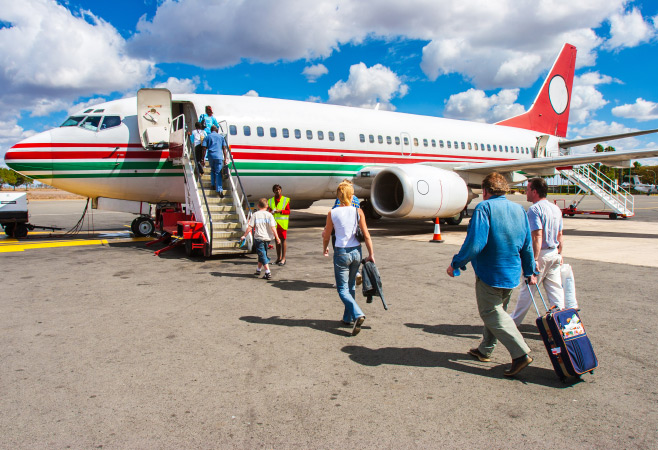
The two main ways to get to Samburu from Nairobi is either by air or by road
Top things to do in Samburu National Reserve
Tucked in the semi-arid rugged terrain of the north of Kenya, Samburu game reserve provides a safari experience that is uniquely different from any we have in the East of Africa. Much less busy as such parks as Maasai Mara, Samburu impresses the visitors with impressive landscapes, exotic wildlife, and local interesting experience. In case you are considering taking up an adventure to this amazing reserve, here are the Top 8 things to do in Samburu, which are guaranteed to make your adventurous journey memorable.
Game Drive Safari
To visit the Samburu wildlife, it is necessary to have morning and evening game drives. In addition to the Special Five, the reserve has elephants, lions, leopards, cheetahs and hyenas as well as much birdlife. Game drives along the Ewaso Ng’iro River are especially rewarding because the animals come here to get water and as such they present good photographic opportunities.
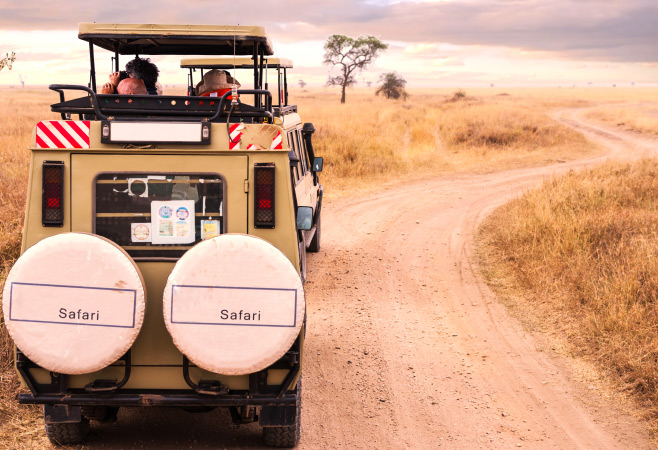
Early morning and late afternoon game drives offer the best chances for spotting active wildlife.
Walking Safaris
Walking safaris are not permitted inside Samburu National Reserve due to national park regulations that prioritize wildlife conservation and visitor safety. However, travelers eager to experience the African bush on foot can enjoy guided walking safaris in neighboring private conservancies, such as Kalama Conservancy, Westgate, or Buffalo Springs Conservancy.
These areas offer unique opportunities to explore the landscape at a slower pace, accompanied by expert local guides. As you walk through dry riverbeds, acacia woodlands, and open savannahs, you’ll learn to identify animal tracks, medicinal plants, insects, and bird calls—details easily missed during game drives. A walking safari delivers a thrilling and educational perspective on the Samburu ecosystem, offering a more intimate and grounded way to connect with the land and its wildlife.
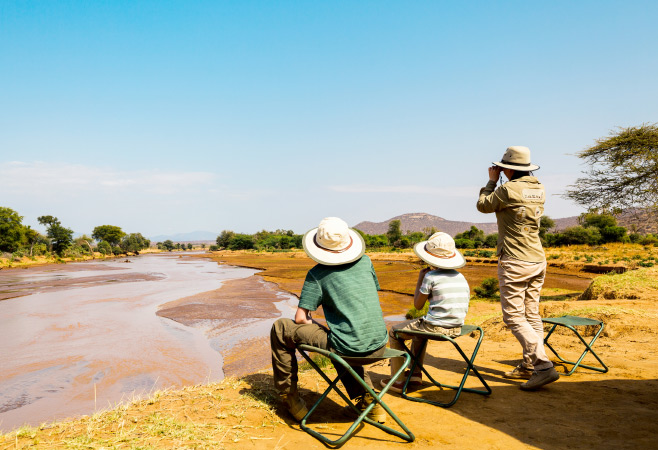
Walking safaris offer a profoundly different and often more intimate way to experience the African
Visit a Samburu Village
A village visit on culture to the neighboring Samburu village provides an opportunity to view the traditional life of the Samburu people, which are similar to that of Maasai. Get to know their traditions, festive costumes, their beadwork and lifestyles. These tours assist in the local populations and form a stronger bond with the area.
Go Birdwatching
With over 450 bird species recorded, Samburu is a paradise for bird lovers. From vibrant kingfishers and bee-eaters to the massive martial eagle, the variety is staggering. Birdwatching deserves a place among the top activities to do in Samburu, especially during or after the rains when migratory species arrive.

Samburu is one of best places to watch bird in Kenya
Spot the Samburu Special Five
One of the top things to do in Samburu is seeking out the iconic “Samburu Special Five.” These unique animals—reticulated giraffe, Grevy’s zebra, Somali ostrich, Beisa oryx, and gerenuk—are specially adapted to the arid landscapes of northern Kenya. Their distinct patterns and behaviors make them fascinating photographic subjects and thrilling wildlife sightings.
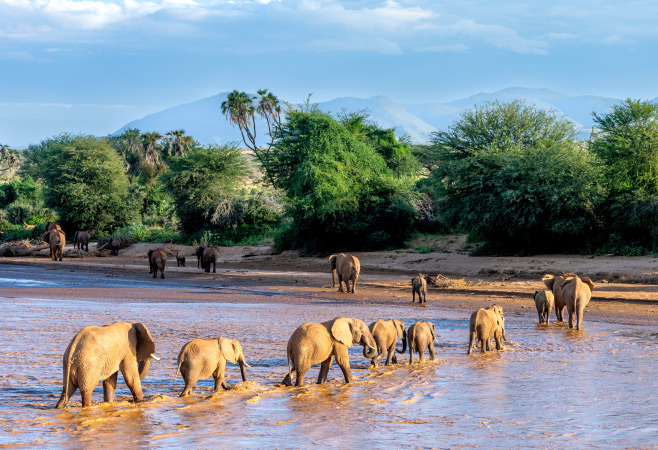
The Samburu Special Five refers to a distinctive collection of wildlife species found in the Samburu National Reserve in northern Kenya
Relax by the Ewaso Ng’iro River
Many lodges are set along the riverbanks, offering serene views and the chance to see elephants, crocodiles, and hippos right from your lodge deck. Relaxing by the river is a perfect way to unwind between game drives.
Capture the Scenery on a Photography Safari
In Samburu, photographers will discover a wealth of inspiration within its dramatic light, rugged hills, and varied wildlife. From capturing sunrise silhouettes and elephants traversing the river to creating portraits of the Samburu people, the reserve provides a rich array of photographic prospects.
Camel Trekking Safari in Samburu
One of the most distinctive experiences available in Samburu National Reserve, beyond typical game drives and walking safaris, is a Camel Trekking Safari. This adventure provides a more leisurely and immersive method of exploring northern Kenya’s semi-arid environments, guided by Samburu warriors who are skilled at handling camels and possess extensive knowledge of the area.
Camel treks are generally conducted in private conservancies adjacent to the reserve, such as Kalama or West Gate Conservancy, where regulations accommodate more flexible activities. Treks can range from short, one- or two-hour experiences to full-day excursions, or even multi-day expeditions that involve camping in remote locations under the stars.
While atop a camel, you’ll gain panoramic views of the savannah, observe wildlife from a unique vantage point, and move unobtrusively through the bush. It’s also a great opportunity to learn about the region's vegetation, animal tracks, and smaller animals that might be overlooked during a vehicle safari.
A camel trekking safari in Samburu is not merely an exciting adventure; it's also a cultural experience, connecting visitors with the traditional lifestyles of northern Kenya.
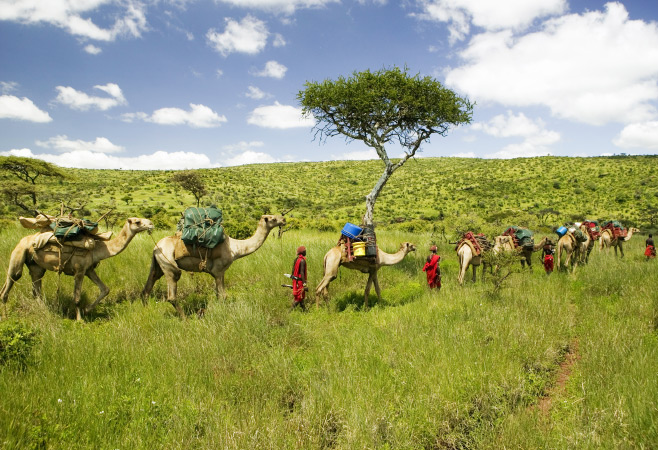
A camelback safari in Samburu allows guests to get up-close with plains game such as zebra, giraffe, and ostrich.
Where to stay in Samburu national reserve
Samburu National Reserve provides an agreeable selection of lodges at various prices and tastes of travelers. No matter whether you are in need of supreme luxury, want mid-range levels of comfort or have less money to spend, you will find something to suit your needs.
Luxury Lodges & Camps
- Saruni Samburu: Situated in the Kalama Conservancy, this location provides panoramic views and stylish villas. It emphasizes individualized service and cultural encounters.
- Sasaab: An exclusive lodge near West Gate, it is characterized by Moroccan-influenced design, private plunge pools, and remarkable views of the Ewaso Ng’iro River.
- Elephant Bedroom Camp: This camp features boutique luxury tents situated along the Ewaso Ng’iro River, with elephants frequently visiting the camp itself.
- Samburu Intrepids Camp: A long-standing tented camp recognized for its superior guiding and services suitable for families.
Mid-Range Options
- Ashnil Samburu Camp: Positioned with a view of the river, it provides comfortable tents equipped with private bathrooms, a swimming pool, and convenient access to prime wildlife habitats.
- Samburu Simba Lodge: Featuring large rooms and excellent value, it is conveniently located near the Buffalo Springs Gate.
Budget Accommodation
- It is short of budget services within the reserve. But there are basic campsites provided by Kenya Wildlife Service (KWS) or other operators that offer equally simple places of accommodation to visitors who would like to experience a better relationship with nature.
Additional Tips
- Private conservancies bordering Samburu also have their own benefits; night game drives, walking safari, and the fact that you will not experience the many crowds that are found in the parks would be some of the pluses when staying within the boundaries of a private conservancy like Kalama or West Gate.
- The lodges and camps usually quote prices that include meals, guided driving safari and in some cases, park fees, which helps to plan the budget of your trip
- Book at least two months in advance, and during the high demand season, July to October to see wildlife.
You can stay in the luxury camp with breathtaking views or the basic camp under the stars, but accommodation in Samburu National Reserve will still remain the unforgettable one due to the wild beauty of the northern part of Kenya.
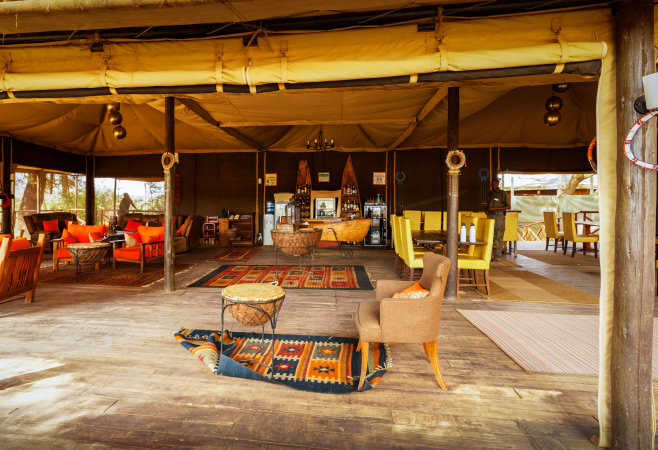
Samburu offers a range of accommodation options, from luxurious tented camps to more budget-friendly lodges
What to Pack for Samburu National Reserve
The weather of Samburu National Reserve is mostly warm and dry, with cooler mornings and evenings, especially during game drives. Proper equipment will keep you comfortable to experience all this beautiful reserve affords you
Clothing:
- Lightweight, breathable fabrics: Cotton or quick-drying synthetics for daytime.
- Neutral colors: Khakis, browns, greens, greys. Avoid bright colors and dark blues (which can attract tsetse flies).
- Long sleeves and trousers: For sun protection and insect bite prevention, especially in the evenings.
- Warm layer: A fleece or jacket for cool early mornings and evenings.
- Footwear: Comfortable walking shoes or sneakers. Sandals or flip-flops for camp.
Sun Protection:
- Wide-brimmed hat
- Sunglasses
- High SPF sunscreen
Insect Repellent:
- Essential, particularly at dawn and dusk.
Camera Gear:
- Binoculars (a must!)
- Camera with a good zoom lens
- Extra batteries and memory cards
Personal Medications:
- Bring all necessary prescription medicines
- Basic first-aid kit (plasters, antiseptic, painkillers, antihistamines, etc.)
Small Daypack:
- For carrying essentials during game drives.
Reusable Water Bottle:
- To stay hydrated and reduce plastic waste.
Chargers/Power Bank:
- For keeping electronics charged in remote areas.
Cash (Kenyan Shillings):
- For tips and local purchases, as card facilities might be limited in remote areas.
Cellular and Internet Connectivity
Cellular signalage in Samburu may prove to be erratic. Buy a local SIM card with Safaricom because it has the best reach, although remote locations will have low signals. Majority of upscale lodges offer bare bones Wi-Fi but it might be quite slow or even temperamental. In case the availability of the internet matters to the work or communication, download the maps, documents, as well as no-internet tools, prior to arrival.
Travel Documents:
- Passport, which must be valid for at least six months after your planned entry date.
- Kenyan ETA printout, if necessary. As of January 2024, all travelers to Kenya must apply for an ETA (Electronic Travel Authorization) before arrival at https://www.kenyaimmigration.org/
- Copies of your travel insurance documentation, encompassing coverage for emergency evacuation.
- Vaccination certificates, if required. This includes, for example, Yellow Fever certificates for those arriving from regions where the disease is prevalent.
- Copies, both digital and physical, of all significant documents for backup purposes.
Thoughtful packing guarantees you're well-equipped for Samburu's distinctive environment, wildlife experiences, and the practicalities of your trip. With these necessities, you'll be fully prepared to savor one of Kenya's most amazing safari locations!

A safari in Samburu National Reserve offers a thrilling experience in the wild, but knowing what to pack and wear is crucial for a comfortable, safe, and enjoyable adventure
Tips for Planning Your Trip
Tour planning to Samburu national reserve can help you make the safari adventure smooth and pleasant. The following are the most important tips that can enable you to make the best of the visit:
- Early Booking of Flights: It is advisable to book flights early especially during the peak season between July and October when there is high demand.
- Fly-Drive: Fly-drive is an option considered not only preferred by some to cover more varieties and see a different landscape as well.
- Check Entry Gates: choose the closest park gate to your lodge to ease logistics and time of transfer.
Health Precautions
- Yellow Fever Vaccination: Yellow Fever vaccination is required only if arriving from a country where the disease is endemic. Always carry your vaccination certificate if required by Kenyan authorities at the point of entry.
- Malaria Prophylaxis: Samburu lies in a malaria-risk area, though the risk is moderate compared to the coast. Ask your doctor about using antimalarial medicine and also take care like insect repellent and wear long sleeves particularly in the morning and at dusk.
Safari Regulations
- Night Drives: Night game drives are strictly prohibited inside Samburu National Reserve, but allowed in nearby private conservancies such as Kalama or West Gate. However, should you wish to get acquainted with nocturnal wildlife, it is worth staying in such a conservancy lodge where this is a special activity.
Crowds and Experience
- Samburu is much less crowded in comparison with renowned parks such as the Maasai Mara, and thus is a more quaint and low profile safari destination. It is a perfect place, which is a paradise of solitude with unusual landscapes and rare species sightings.
Conclusion
Samburu National Reserve offers a truly unique and enriching safari experience. Its distinctive wildlife, dramatic landscapes, and vibrant cultural interactions provide a captivating contrast to other Kenyan parks. For those seeking an authentic taste of Kenya's wild north, a journey to Samburu promises unforgettable wildlife encounters and a profound connection with one of Africa's most special ecosystems. It's a destination that leaves a lasting impression, showcasing the enduring beauty and resilience of nature.
Related Articles
- The Ultimate Foodie’s Guide: The 13 Best Restaurants in Watamu, Kenya
- The Ultimate Guide to Shopping in Mombasa: Markets, Malls & Must-Buy Items
- Explore the Best Hotels in Nyeri: Where to Stay for Comfort and Value
- A Culinary Journey: The 12 Best Restaurants You Need to Try in Westlands, Nairobi
- More Than Just Lake Victoria: A Tourist's Guide to the Best Nightlife Experiences in Kisumu
- The Ultimate Tea Explorer: Discover the 11 best places to visit in Limuru a Quiet Weekend Escape
- From Peaks to Plains: Exploring the 11 Best Places to visit in Kitale for Your Bucket List
- From Luxury to Comfort: A Guide to the Top 14 Hotels in Nakuru for Unforgettable Memories
- A Guide to the Best Cafés and Coffee Shops in Momba for Quality Brews and Unbeatable Vibes
- Dancing Until Dawn: Discovering the Ultimate Nightlife in Mombasa, Kenya











